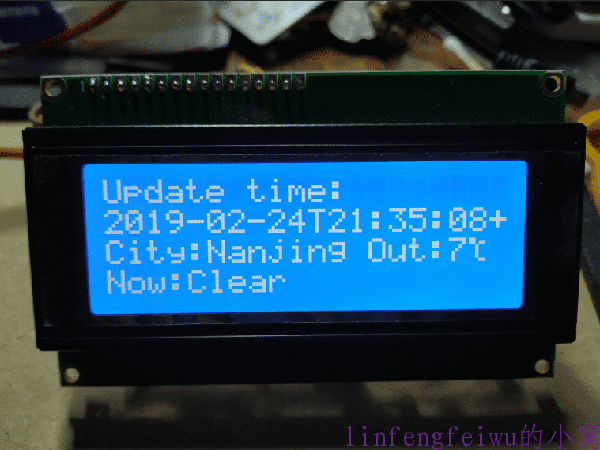一个很简单的天气显示系统,采用lcd2004作为显示器,能够显示当前联网获得的天气,配合之前室内的那个温度来用,绝配啊。
连线很简单,只需将2004按IIC方式连接在esp8266上即可。
代码:
#include <ESP8266WiFi.h>
#include <ArduinoJson.h>
#include <Wire.h>
//GPIO4(SDA) GPIO5(SCL)
//I2C LCD:
#include <Wire.h> // Comes with Arduino IDE
#include <LiquidCrystal_I2C_DS3231.h>
// Set the LCD I2C address
#define I2C_ADDR 0x27 // Define I2C Address for the PCF8574T
//---(Following are the PCF8574 pin assignments to LCD connections )----
// This are different than earlier/different I2C LCD displays
#define Rs_pin 0
#define Rw_pin 1
#define En_pin 2
#define BACKLIGHT_PIN 3
#define D4_pin 4
#define D5_pin 5
#define D6_pin 6
#define D7_pin 7
#define LED_OFF 0
#define LED_ON 1
/*-----( Declare objects )-----*/
LiquidCrystal_I2C lcd(I2C_ADDR,En_pin,Rw_pin,Rs_pin,D4_pin,D5_pin,D6_pin,D7_pin);
#define ledPin 14 // 定义ledPin连接到GPIO14
//年
byte Nian[8] = {0b01000,0b01111,0b10010, 0b01111, 0b01010, 0b11111, 0b00010, 0b00010};
//月
byte Yue[8] = {0b01111, 0b01001, 0b01111, 0b01001, 0b01111, 0b01001, 0b10011, 0b00001};
//日
byte Ri[8] = {0b01111, 0b01001, 0b01001, 0b01111, 0b01001, 0b01001, 0b01111, 0b00000};
//摄氏度
byte du[8] = {0b11000,0b11011,0b00100, 0b00100, 0b00100, 0b00100, 0b00011, 0b00000};
const char* ssid = " XXXXXX"; // XXXXXX -- 使用时请修改为当前你的 wifi ssid
const char* password = " XXXXXX"; // XXXXXX -- 使用时请修改为当前你的 wifi 密码
const char* host = "api.seniverse.com";
const char* APIKEY = "wcmquevztdy1jpca"; //API KEY
const char* city = "nanjing";
const char* language = "en";//zh-Hans 简体中文 会显示乱码
const unsigned long BAUD_RATE = 115200; // serial connection speed
const unsigned long HTTP_TIMEOUT = 5000; // max respone time from server
const size_t MAX_CONTENT_SIZE = 1000; // max size of the HTTP response
// 我们要从此网页中提取的数据的类型
struct UserData {
char city[16];//城市名称
char weather[32];//天气介绍(多云...)
char temp[16];//温度
char udate[32];//更新时间
};
WiFiClient client;
char response[MAX_CONTENT_SIZE];
char endOfHeaders[] = "\r\n\r\n";
/**
* @Desc 初始化操作
*/
void setup() {
lcd.begin(20, 4);
// Switch on the backlight
lcd.setBacklightPin(BACKLIGHT_PIN,POSITIVE);
lcd.setBacklight(LED_ON);
lcd.createChar(0, Nian);
lcd.createChar(1, Yue);
lcd.createChar(2, Ri);
lcd.createChar(3, du);
WiFi.mode(WIFI_STA); //设置esp8266 工作模式
Serial.begin(BAUD_RATE);
delay(10);
Serial.println();
Serial.println();
Serial.print("Connecting to ");//写几句提示,哈哈
Serial.println(ssid);
WiFi.begin(ssid, password); //连接wifi
while (WiFi.status() != WL_CONNECTED) {
//这个函数是wifi连接状态,返回wifi链接状态
delay(100);
Serial.print(".");
}
Serial.println("");
Serial.println("WiFi connected");
delay(100);
Serial.println("IP address: ");
Serial.println(WiFi.localIP());//WiFi.localIP()返回8266获得的ip地址
client.setTimeout(HTTP_TIMEOUT);
}
/**
* @Desc 主函数
*/
void loop() {
while (!client.connected()){
if (!client.connect(host, 80)){
Serial.println("connection....");
delay(100);
}
}
if (sendRequest(host, city, APIKEY) && skipResponseHeaders()) {
clrEsp8266ResponseBuffer();
readReponseContent(response, sizeof(response));
UserData userData;
if (parseUserData(response, &userData)) {
printUserData(&userData);
}
}
delay(300);//每5s调用一次
}
/**
* @发送请求指令
*/
bool sendRequest(const char* host, const char* cityid, const char* apiKey) {
// We now create a URI for the request
//心知天气
String GetUrl = "/v3/weather/now.json?key=";
GetUrl += apiKey;
GetUrl += "&location=";
GetUrl += city;
GetUrl += "&language=";
GetUrl += language;
// This will send the request to the server
client.print(String("GET ") + GetUrl + " HTTP/1.1\r\n" +
"Host: " + host + "\r\n" +
"Connection: close\r\n\r\n");
Serial.println("create a request:");
Serial.println(String("GET ") + GetUrl + " HTTP/1.1\r\n" +
"Host: " + host + "\r\n" +
"Connection: close\r\n");
delay(100);
return true;
}
/**
* @Desc 跳过 HTTP 头,使我们在响应正文的开头
*/
bool skipResponseHeaders() {
// HTTP headers end with an empty line
bool ok = client.find(endOfHeaders);
if (!ok) {
Serial.println("No response or invalid response!");
}
return ok;
}
/**
* @Desc 从HTTP服务器响应中读取正文
*/
void readReponseContent(char* content, size_t maxSize) {
size_t length = client.peekBytes(content, maxSize);
delay(100);
Serial.println("Get the data from Internet!");
content[length] = 0;
Serial.println(content);
Serial.println("Read data Over!");
client.flush();//这句代码需要加上 不然会发现每隔一次client.find会失败
}
/**
* @Desc 解析数据
* 数据格式如下:
* {
* "results": [
* {
* "location": {
* "id": "WX4FBXXFKE4F",
* "name": "北京",
* "country": "CN",
* "path": "北京,北京,中国",
* "timezone": "Asia/Shanghai",
* "timezone_offset": "+08:00"
* },
* "now": {
* "text": "多云",
* "code": "4",
* "temperature": "23"
* },
* "last_update": "2017-09-13T09:51:00+08:00"
* }
* ]
*}
*/
bool parseUserData(char* content, struct UserData* userData) {
// -- 根据我们需要解析的数据来计算JSON缓冲区最佳大小
// 如果你使用StaticJsonBuffer时才需要
// const size_t BUFFER_SIZE = 1024;
// 在堆栈上分配一个临时内存池
// StaticJsonBuffer<BUFFER_SIZE> jsonBuffer;
// -- 如果堆栈的内存池太大,使用 DynamicJsonBuffer jsonBuffer 代替
DynamicJsonBuffer jsonBuffer;
JsonObject& root = jsonBuffer.parseObject(content);
if (!root.success()) {
Serial.println("JSON parsing failed!");
return false;
}
//复制我们感兴趣的字符串
strcpy(userData->city, root["results"][0]["location"]["name"]);
strcpy(userData->weather, root["results"][0]["now"]["text"]);
strcpy(userData->temp, root["results"][0]["now"]["temperature"]);
strcpy(userData->udate, root["results"][0]["last_update"]);
// -- 这不是强制复制,你可以使用指针,因为他们是指向“内容”缓冲区内,所以你需要确保
// 当你读取字符串时它仍在内存中
return true;
}
// 打印从JSON中提取的数据
void printUserData( struct UserData* userData) {
Serial.println("Print parsed data :");
lcd.clear();
lcd.setCursor(0,0);
lcd.print("Update time:");
lcd.setCursor(0,1);
lcd.print(userData->udate);
lcd.setCursor(0,2);
lcd.print("City:");
lcd.print(userData->city);
lcd.print(" Out:");
lcd.print(userData->temp);
lcd.write(byte(3));
lcd.setCursor(0,3);
lcd.print("Now:");
lcd.print(userData->weather);
delay(4*1000);
}
// 关闭与HTTP服务器连接
void stopConnect() {
Serial.println("Disconnect");
client.stop();
}
void clrEsp8266ResponseBuffer(void){
memset(response, 0, MAX_CONTENT_SIZE); //清空
}
lcd2004的使用基本参照1602来,库也是一样的,只要改变下显示位置就行了。获取网络天气的代码来自:http://bbs.doit.am/forum.php?mod=viewthread&tid=442&extra=。没有自己去申请api,直接用了原作者的。哪一天失效了再自己改吧。
成品图:





发表评论: